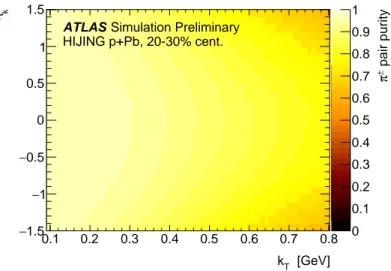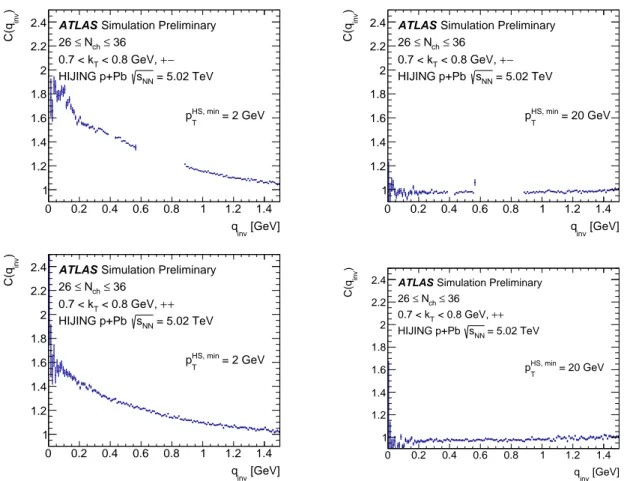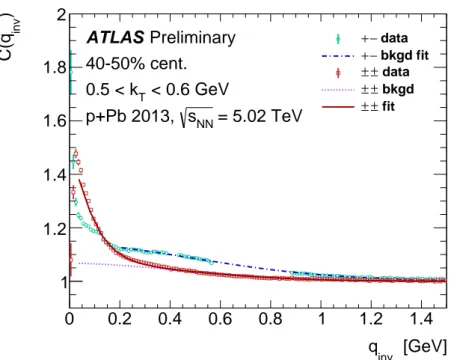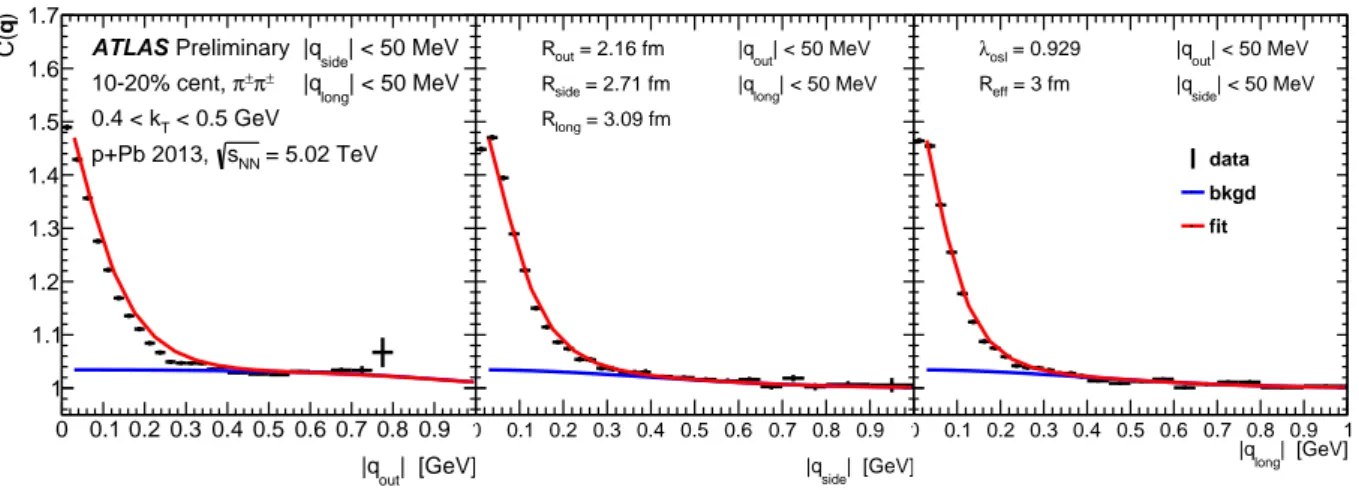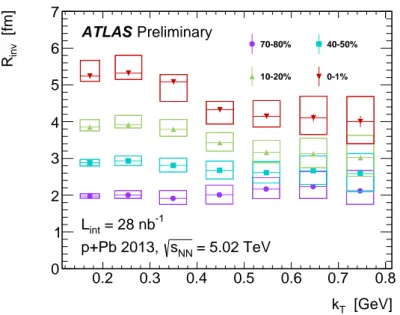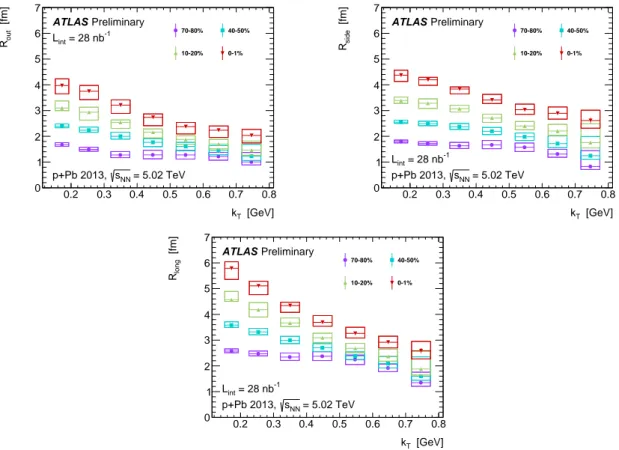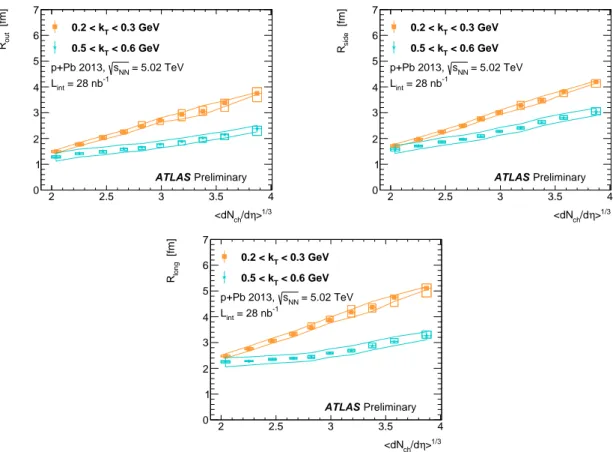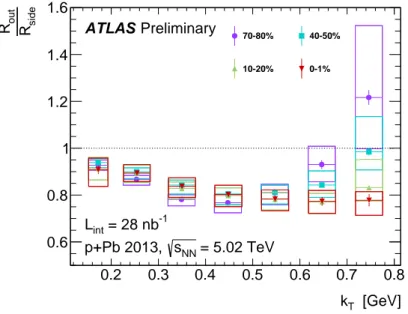ATLAS-CONF-2015-054 28September2015
ATLAS NOTE
ATLAS-CONF-2015-054
26th September 2015
Femtoscopy with identified charged pions in proton-lead collisions at √
s NN = 5.02 TeV with ATLAS
The ATLAS Collaboration
Abstract
Bose-Einstein correlations between identified charged pions are measured for
p+Pb colli-sions at
√sNN =
5.02 TeV with the ATLAS detector with a total integrated luminosity of 28 nb
−1. Pions are identified using ionisation energy loss measured in the pixel detector.
Two-particle correlation functions and the extracted source radii are presented as a func- tion of average transverse pair momentum (k
T) and collision centrality. Pairs are selected with a pseudorapidity between -1.5 and 1.5 and with an average transverse momentum 0.1
< kT <0.8 GeV. The e
ffect on the two-particle correlation function from jet frag- mentation is studied, and a new method for constraining its contributions to the measured correlations is described. The measured source sizes are substantially larger in more central collisions and are observed to decrease with increasing pair
kT. Linear scaling of the volume with the average multiplicity in the acceptance region
|η| <1.5 is observed. The scaling of the extracted radii with the mean number of participants is also used to compare a selection of initial-geometry models.
c
2015 CERN for the benefit of the ATLAS Collaboration.
Reproduction of this article or parts of it is allowed as specified in the CC-BY-3.0 license.
1 Introduction
While hydrodynamic models are applied successfully to nucleus-nucleus (A+A) collisions, the extent to which they can describe
p+Pb collisions remains a topic of active debate. Femtoscopy, the method of using final-state interactions to probe the space-time extent of a particle-emitting source, provides important input to this discussion [1].
Correlation functions of outgoing particle pairs are often studied in A
+A collisions as a function of rel- ative pseudorapidity (
∆η) and azimuthal angle (∆φ). For |∆η| &2 the jet contribution does not appear, and the correlation function
C(∆η,∆φ) is then seen to be independent of∆η[2–7]. These long-range correlations are known as the “ridge”. The pair production is often decomposed into Fourier modes:
dN/d∆φ∼
1
+2
Σnvn(p
aT)v
n(
pbT) cos(n∆φ). The measured
vncomponents are consistent with hydrody- namic evolution.
Recent observations of the ridge in
p+Pb [8–10] and
pp[11, 12] collisions, where the system size is much smaller than in Pb+Pb, raise questions over the interpretation of the
vnas being purely of hydrodynamic origin. Both hydrodynamic [13–16] and initial-state [17–21] models, as well as a hybrid scenario [22], are able to describe the observed
v2and
v3in
p+Pb collisions.
The Hanbury Brown and Twiss (often abbreviated as “HBT”) method originated in astronomy [23, 24], where space-time correlations of photons due to wavefunction symmetrisation are used to measure the size of distant stars. The procedure can be adapted to the tiny sources encountered in hadronic colli- sions if identical-particle Bose-Einstein correlations are instead studied in relative momentum space [25].
Measurements of these Bose-Einstein correlations in
ppcollisions at
√s =
0.9 GeV and
√s =
7 GeV have been produced by ATLAS [26], CMS [27], and ALICE [28]. At both energies the source radii are observed to decrease with rising transverse pair momentum
kT. It is also observed that the radii increase with particle multiplicity but saturate at the highest multiplicities.
Although Bose-Einstein correlations are the most straightforward to measure experimentally, any non- trivial interaction can be used in principle to image the source density. The term
femtoscopyis often used to refer to any measurement that provides spatio-temporal information about a hadronic source [29].
The measured source radii are interpreted as the dimensions of a nuclear source at freeze-out, after all interactions between final-state particles and the bulk have ceased; thus, they are sensitive to the space- time evolution of the event. In particular, an increase in radii at low momentum indicates radial expansion since higher momentum particles are more likely to be produced earlier in the event [30]. The results of femtoscopic measurements in
p+Pb systems are of significant interest because they can provide insightinto the extent to which hydrodynamics applies in such small systems. While femtoscopic methods have already been applied to
p+Pb systems at the LHC [31,32], this analysis presents new data-driven techniques to constrain the significant background contribution from jet fragmentation, referred to in this note as the “hard process” background.
The results presented in this analysis are shown for collision centralities ranging from 0% to 80%, in
centrality intervals no greater than 10% (see Sect. 3.1 for centrality definition). For a pair’s average
four-momentum
k, the pair pseudorapidity
ηkis selected from
|ηk| <1.5 and the results are shown as
a function of transverse pair momentum 0.1 GeV
< kT <0.8 GeV. One- and three-dimensional source
radii are presented as a function of the average charged-particle multiplicity, and the scaling of the system
size with the number of initial nucleon participants is also investigated, using the predictions of three
initial-geometry models.
2 ATLAS detector
The ATLAS detector is described in detail in Ref. [33]. The inner detector (ID), which is immersed in a 2 Tesla axial magnetic field, is used to reconstruct charged particles within
|η| <2.5
1. It consists of a silicon pixel detector, a semi-conductor tracker (SCT) made of double-layered silicon microstrips, and a transition radiation tracker made of straw tubes. A particle travelling from the interaction point with
|η| <
2 crosses at least 3 pixel layers, 4 double-sided micro-strip layers and typically 36 straw tubes.
The forward calorimeter (FCal), covering a pseudorapidity region of 3.1
< |η| <4.9, is used to measure the centrality of each collision. The FCal uses liquid argon as the active medium with tungsten and copper absorbers.
The Minimum Bias Trigger Scintillators (MBTS), consisting of two arrays of scintillation counters, are positioned at
z =±3.6 m and cover 2.1 < |η| <3.9. They are used for the MinBias Level-1 trigger [34]
as well as to impose a constraint on the event selection.
3 Data analysis
3.1 Event and track selection
This analysis uses data from the LHC 2013
p+Pb run at √sNN =
5.02 TeV with an integrated luminosity of 28.1 nb
−1. The Pb ions had an energy per nucleon of 1.57 TeV and collided with the 4 TeV proton beam to yield a centre-of-mass energy
√sNN =
5.02 TeV with a longitudinal rapidity boost of 0.465 in the proton direction relative to the ATLAS laboratory frame. Events are required to satisfy the Level-1 MinBias trigger and to have a hit on each side of the MBTS. The di
fference in time between the activity in each side can be no greater than 10 ns. Only a single reconstructed primary vertex (PV) is allowed, which is required to have at least two good tracks. Events which have more than one reconstructed vertex (including secondary vertices) with either more than 10 tracks or a scalar sum of track
pTgreater than 6 GeV are rejected.
Event centrality is determined following the procedure in Ref. [35], using the total transverse energy in the Pb-going side of the FCal. The use of the FCal for measuring centrality has the advantage that it is not sensitive to multiplicity fluctuations in the kinematic region covered by the inner detector, where the fem- toscopic measurement is performed. For each centrality interval the average charged-particle multiplicity
hd Nch/dηiis measured and the corresponding average number of participating nucleons
hNpartiis derived using methods and data also described in Ref. [35]. Since this analysis uses finer centrality intervals (no wider than 10%), a linear interpolation is used to construct new values based on the published results.
The values and errors from this procedure are tabulated in Sect. 6.2.
Reconstructed tracks, taken from
|η|<2.5 at
pT >0.1 GeV, must originate from hits near the interaction point. A minimum of one pixel hit is required, and if the track crosses an active module in the innermost layer, a hit in that layer is required. For a track
pTgreater than 0.1, 0.2, or 0.3 GeV there must be at least 2, 4, or 6 hits in the SCT, respectively. The transverse impact parameter with respect to the primary vertex,
1ATLAS uses a right-handed coordinate system with its origin at the nominal interaction point (IP) in the centre of the detector and thez-axis along the beam pipe. The x-axis points from the IP to the centre of the LHC ring, and the y-axis points upward. Cylindrical coordinates (r, φ) are used in the transverse plane,φbeing the azimuthal angle around the beam pipe.
The pseudorapidity is defined in terms of the polar angleθasη=−ln tan(θ/2).
dPV0
, must be such that
|d0PV| <1.5 mm. The corresponding longitudinal impact parameter must satisfy
|zPV0
sin
θ| <1.5 mm. Neither
|d0PV|nor
|zPV0sin
θ|can be larger than 3 times its uncertainty as derived from the covariance matrix of the track parameter fit.
3.2 Particle identification
Particle identification (PID) is performed through measurements of the energy loss
dE/dxacquired from the ionization charge deposited in the pixel clusters crossed by a track. Relative likelihoods that the track is a
π, K, and
pare formed by fitting the
dE/dxdistributions to
√s =
7 TeV
ppdata in several momentum intervals [36]. Three PID selection levels are defined: one designed to have a high efficiency for pions, one designed to result in high purity, and a middle ground which was chosen as the nominal selection level. The e
fficiency and purity of these selections are studied in a
p+Pb sample generated using Hijing [37] and simulated with the GEANT4 package [38]. The sample is reconstructed with the same conditions as the data. The resulting purity of pairs in the nominal selection is shown in Fig. 1. The results are also evaluated at the looser and tighter PID definitions, and the variation is incorporated into the systematic uncertainty.
[GeV]
kT
0.1 0.2 0.3 0.4 0.5 0.6 0.7 0.8
kη
−1.5
−1
−0.5 0 0.5 1 1.5
pair purity±π
0 0.1 0.2 0.3 0.4 0.5 0.6 0.7 0.8 0.9 1 Simulation Preliminary
ATLAS
HIJING p+Pb, 20-30% cent.
Figure 1: Purity of identified pion pairs, from fully simulated Hijingp+Pb events, as a function of the pair’s average transverse momentumkTand pseudorapidityηk.
3.3 Pair selection
Track pairs are required to have
|∆φ| < π/2 to avoid an enhancement in the correlation function arisingprimarily from dijets. This enhancement is not present in the signal region but can influence the results by a
ffecting the overall normalization factor in the fits. For a pair’s average momentum
k = 12pa+pb
the pseudorapidity
ηkmust lie inside
|ηk| <1.5 (a narrower window than the track selection of
|η| <2.5). When analyzing track pairs of opposite sign, selections on the invariant mass are applied such that
mππ−mρ0
>
150 MeV,
mππ−mK0 S
>
20 MeV, and
mK K −mφ(1020)
>
20 MeV, where
mabis
the pair’s invariant mass calculated with particle masses
maand
mb. These selections are applied when
forming both the same- and mixed-event distributions.
3.4 Correlation function
The two-particle correlation function is defined as the ratio of two-particle and single-particle momentum spectra:
C pa,pb
≡
dNa b d3pad3pb dNa d3pa
dNb d3pb
,
(1)
for pairs of particles with four-momenta
paand
pb. Utilising the correlation function as defined in this way has the experimental advantage that most of the single-particle e
fficiency, acceptance, and resolution effects cancel in the ratio.
It is of physical interest to evaluate the correlation function as a function of the relative momentum
2 q ≡ pa −pbin intervals of average momentum
k ≡ 12pa+pb
. The relative momentum distribution
A(q) ≡ dNdqsame
is formed by selecting pairs of particles from each event in an event class, which is defined by the collision centrality and
zposition of the primary vertex. The background
B(q) ≡ dNdqmix
is constructed by event mixing, that is, by selecting one particle from each of two events in the same event class as
A(q). The ratio of the distributions defines the correlation function:Ck
(q)
≡ Ak(q)
Bk
(q)
.(2)
The relative momentum correlation functions are studied as a function of
qinv ≡ p−qµqµ
and the three- vector
q. When working in all three dimensions, a longitudinally co-moving frame (LCMF) with the pairof particles is used such that
kz =0. The coordinate axes are defined according to the “out-side-long”
convention [39–41]:
qout ≡kT ·q
|kT| = |paT|2− |pTb|2
2k
T,
(3)
qside ≡
(ˆ
z×kT)
·q|kT| =−
ˆ
z·paT ×pTb
kT ,
(4)
qlong ≡ˆz·q= pzaEb−pzbEa q
k02−k2z
.
(5)
2Whileqhere refers to the relative four-momentum, it is also used generically to refer to either the Lorentz invariantqinvor three-vectorq. The correlation function is studied in terms of both these variables but the description of the analysis is nearly identical for both cases.
3.5 Parameterization and fitting of the correlation function
In the approximation that all particles are identical pions created in a fully chaotic source and that they have no final-state interactions, the correlation function is enhanced by the Fourier transform of the source density. This description is useful for guiding intuition, but is not sufficient for a complete analysis. The Bowler-Sinyukov formalism [42, 43] is used to account for final-state corrections:
Ck
(
q) =(1
−λ)+λK(q)C
BE(q)
,(6) where
Kis a factor for final-state corrections, and
CBE(q)
=1
+F[S
k] (q) with
F[S
k] (q) denoting the Fourier transform of the two-particle source density function
Sk(r ). A number of factors influences the value of the experimental parameter
λ, which is constrained between 0 and 1. Including non-identicalparticles decreases this parameter, as does coherent emission. Products of weak decays or long-lived resonances are emitted at a length scale greater than can be resolved by the momentum resolution of the detector, and also lead to a decrease in
λ. These additional contributions to the source density are notCoulomb-corrected in the Bowler-Sinyukov form. When describing pion pairs of opposite charge, there is no Bose-Einstein enhancement and
CBE →1.
The particular choice of the correction factor
K(q) is determined using the formalism in Ref. [44], underthe approximation that the Coulomb correction is e
ffectively applied over a Gaussian source density of radius
Reff:
K
(q
inv)
=G(qinv)
"
1
+8R
eff√πa2F2
1 2
,1; 3
2
,3
2 ;
−R2effq2inv!#
,
(7)
where
G(qinv) is the Gamow factor [45]
G(qinv)
= aq4πinv e4π aqinv −
1
−1
,
a =388 fm is the Bohr radius of two pions, and
2F2is a generalised hypergeometric function.
The Bose-Einstein enhancement in the correlation function is fit to an exponential form,
CBE
(q)
=1
+e− | |Rq| |,(8)
where
qrefers to either
qinvor
qdepending on whether it is applied to the one- or three-dimensional correlation function, and
Ris a diagonal matrix in one or three dimensions whose components are the source radii. The double-bar expression
||Rq||indicates the vector magnitude of
Rqin three dimensions and the absolute value of
Rinvqinvin one dimension. This function corresponds to an underlying Cauchy source density. A Gaussian enhancement is found to not describe the data as well as an exponential, which is also observed in the
ppresults in Ref. [26]. The choice of form for
F[S
k](q) must be taken into account when interpreting source radii, and there is no simple correspondence between results using one form and those using another.
A negative log-likelihood ratio
Lis minimised that assumes the bin contents of
Aand
Bare Poisson distributed and
Cis best fit to the ratio of their means:
−2 lnL =
2
Xi
"
Ai
ln (1
+Ci)
Ai Ci(
Ai+Bi+2)
!
+
(B
i+2) ln (1
+Ci)(
Bi+2)
Ai+Bi +2
!#
.
(9)
The factor
−2 makes this statistic approach χ2in the high-statistics limit. Here
Aand
Bare the quantities in Eq. 2 when considered as histograms, such that
Aiand
Biare the contents in bin
i.Ciis shorthand for
C(q
i) where
qiis the bin centre and
C(q) is the fitting function describing the correlation. The statisticaluncertainties in the fit parameters of
C(q) are selected from the points in the parameter space where
−2 lnL=
min (−2 ln
L)+1.
4 Hard-process contribution
Additional non-femtoscopic enhancements to the correlation functions at
qinv.0.5
−1 GeV are observed in both
+−(opposite charge) and
±±(same charge) pairs. This section describes the Monte Carlo (MC) generators used to study these structures and presents the study performed to constrain their description.
4.1 Monte Carlo generators
Four Monte Carlo generator-level samples are used to study the background described in this section at the truth level. No subsequent simulation is performed, as the effects of the reconstruction were studied using full simulation and found to be negligible. In each of the following samples, 50 million minimum-bias events are generated at a centre-of-mass energy per nucleon-nucleon pair of
√sNN =
5.02 TeV.
1. H
ijingp+Pb [37]
The same settings as in the nominal ATLAS
p+Pb reconstructed simulation (as described in Sect. 3.2) are used, except that the minimum hard-scattering
pTis adjusted as described in Sect. 4.2. A boost is applied along the collision axis in the proton-going direction to match the frame of the measured
p+Pb system.
2. H
ijingppThe generator is run with all of the same settings as the
p+Pb sample, except that both incoming particles are protons and no boost is applied.
3. P
ythia8
pp[46]
The default ATLAS tune “UE AU2-CTEQ6L1” is used with P
ythia8.209, which utilises the CTEQ 6L1 parton distribution function (PDF) from LHAPDF6 [47].
4. H
erwig++pp[48]
The NNLO MRST PDF [49] was used with H
erwig++2.7.1.
4.2 Data-driven estimate of hard process backgrounds
The non-femtoscopic enhancement is more prominent at higher
kTand lower multiplicities. This suggests that the correlation is primarily due to jet fragmentation. This attribution is verified by studying corre- lation functions in Hijing where the contribution from jets can be removed by increasing the minimum hard-scattering
pTfrom 2 to 20 GeV, as demonstrated in Fig. 2.
The amplitude of the hard-process contribution tends to be larger in Monte Carlo generators than it is
in the data. Thus, attempting to account for it by studying the double-ratio
Cdata(
q)/CMC(q) leads to a
depletion that is apparent in the region where the Bose-Einstein enhancement disappears [26]. Another
[GeV]
qinv
0 0.2 0.4 0.6 0.8 1 1.2 1.4
) invC(q
1 1.2 1.4 1.6 1.8 2 2.2
2.4 ATLAS Simulation Preliminary
≤ 36 Nch
≤ 26
− + < 0.8 GeV, 0.7 < kT
= 5.02 TeV sNN
HIJING p+Pb
= 2 GeV
HS, min
pT
[GeV]
qinv
0 0.2 0.4 0.6 0.8 1 1.2 1.4
) invC(q
1 1.2 1.4 1.6 1.8 2 2.2
2.4 ATLAS Simulation Preliminary
≤ 36 Nch
≤ 26
− + < 0.8 GeV, 0.7 < kT
= 5.02 TeV sNN
HIJING p+Pb
= 20 GeV
HS, min
pT
[GeV]
qinv
0 0.2 0.4 0.6 0.8 1 1.2 1.4
) invC(q
1 1.2 1.4 1.6 1.8 2 2.2
2.4 ATLAS Simulation Preliminary
≤ 36 Nch
≤ 26
+ + < 0.8 GeV, 0.7 < kT
= 5.02 TeV sNN
HIJING p+Pb
= 2 GeV
HS, min
pT
[GeV]
qinv
0 0.2 0.4 0.6 0.8 1 1.2 1.4
) invC(q
1 1.2 1.4 1.6 1.8 2 2.2
2.4 ATLAS Simulation Preliminary
≤ 36 Nch
≤ 26
+ + < 0.8 GeV, 0.7 < kT
= 5.02 TeV sNN
HIJING p+Pb
= 20 GeV
HS, min
pT
Figure 2: Correlation functions of truth-level charged particles from Hijingfor+−pairs (top) and++pairs (bottom).
The generator is run with the minimum hard-scatteringpHS, minT at the default setting of 2 GeV (left) and turned up to 20 GeV (right) to remove the contribution from hard processes. The gaps in the opposite-sign correlation functions are a result of the selections described in Sect.3.3, which remove the largest resonance contributions.
commonly used method is to parameterize the mini-jet contribution using MC and allow one or more parameters of the description to be free in the fit [31, 32].
The analysis presented in this note avoids both of these strategies and instead develops a data-driven method to constrain the correlations from jet fragmentation. Opposite-sign correlation functions are used to predict the jet contribution in the same-sign correlation function. This has two clear di
fficulties. Firstly, resonance decays appear prominently in the opposite-sign correlations. The most prominent of these are removed by selections on the invariant mass of the opposite-sign pairs (as described in Sect. 3.3), and the fits ignore opposite-sign structure below
qinv=0.2 GeV. Secondly, jet fragmentation a
ffects the opposite- sign correlations at a different level than it does for same-sign pairs. This is in part because opposite-sign pairs are more likely to have a closer common ancestor in a jet’s fragmentation into hadrons.
To account for the remaining differences between
+−and
±±pairs, a study of the correlation function comparison is performed in P
ythia8. H
ijing, which uses P
ythia6, was found to describe the charge comparison inadequately. Fits are performed to a stretched exponential function of the form
C
(q
inv)
=N1
+λbkgde− |Rbkgdqinv|αbkgd,
(10)
where
Nis a normalization factor and the other parameters depend on the charge combination and on
kT. First,
αbkgdis determined with fits to same-sign correlation functions. The fits are well described by a Gaussian form (α
bkgd=2) at
kT .0.4 GeV. The shape parameter
αbkgdis only very weakly dependent on multiplicity, so a function is fit to parameterize
αbkgdas a function of
kT. The fits to correlation functions are performed again with
αbkgdfixed to the same value in same- and opposite-charged pairs, and a comparison is made between the width parameters
Rbkgd+−and
R±±bkgd. The width of the jet fragmentation correlation for same-sign pairs is found to be roughly proportional to that for opposite-sign pairs:
Rbkgd±± = ρR+bkgd− .
(11) This proportionality begins to break down at low
kT, but in this kinematic region hard processes contribute little to the correlation function (i.e.
λbkgdis small). The multiplicity of charged particles,
Nch, is the number of truth-level charged particles for
pT >0.1 GeV and
|η| <2.5. The
ρparameter is extracted as a
kT- and multiplicity-independent factor. Finally,
R±±bkgdis also fixed from
Rbkgd+−using the value of
ρ, andthe fits are performed again to parameterize the relationship between the amplitudes:
λ±±bkgd= µ(kT
)
λ+bkgd− ν(kT)
.
(12)
At each
kT,
µand
νare fit to describe four multiplicity intervals (26
≤ Nch ≤36, 37
≤ Nch ≤48, 49
≤ Nch ≤64, and 65
≤ Nch). The power-law scaling of Eq. 12 is found to provide a good description of the relation between the same- and opposite-sign amplitudes across all four multiplicity intervals studied.
The multiplicity-independence of
µand
νis important to justify the use of these parameters in
p+Pb.Since this study is done with P
ythia8 in a
ppsystem, H
ijingis also used to compare the correspondence between opposite- and same-sign pairs in both
ppand
p+Pb. While the mapping is mostly consistent between the two systems, it is found that
µis larger in
p+Pb than in ppby 8.5% on average. When the mapping is applied to the data, this factor is also taken into account, and the standard deviation of this factor is incorporated into a systematic uncertainty.
With
αbkgd(
kT),
µ(kT),
ν(kT), and
ρdetermined from generator-level samples, the mapping can be applied to the
p+Pb data. As illustrated in Fig. 3, the
+−correlation function is fit to Eq. 10 for
qinv >0.2 GeV, with
αbkgdfixed from Pythia 8 and
λ+bkgd−and
Rbkgd+−as free parameters. The
µ,ν, and ρare used to infer
λ±±bkgdand
R±±bkgd, which are fixed before the femtoscopic part of the correlation function is fit to
±±data.
In three dimensions,
qinvis calculated from
qand the average
kTin each bin. The same parameters used to describe the hard-process contribution in the invariant correlation function are also used in the 3D fit.
The full form of the correlation function fit to
±±data including the hard-process background description is
C
(q)
=N1
−λ+λK(q
inv)C
BE(q)
1
+λ±±bkgde− |R±±bkgdqinv|αbkgd
,
(13)
where
qrefers generically to either
qinvor
q.[GeV]
q
inv0 0.2 0.4 0.6 0.8 1 1.2 1.4
)
invC(q
1 1.2 1.4 1.6 1.8 2
data
− +
bkgd fit
− +
data
±
± bkgd
±
±
± fit
±
Preliminary ATLAS
40-50% cent.
< 0.6 GeV 0.5 < k
T= 5.02 TeV s
NNp+Pb 2013,
Figure 3: Correlation functions inp+Pb data for opposite-sign (teal circles) and same-sign (red squares) pairs. The opposite-sign correlation function, with the most prominent resonances removed, is fit to a function of the form in Eq.10(blue dashed line). The violet dotted line is the estimation of the jet contribution in the same-sign correlation function, also of the form of Eq.10, and the dark red line is the full fit of Eq.13to the same-sign data.
5 Systematic uncertainties
Systematic uncertainties are determined to account for the hard-process background description, PID, the effective Coulomb correction size
Reff, charge asymmetry, and two-particle effects.
One of the largest sources of uncertainty in femtoscopy in small systems in high-energy collisions comes from forming an accurate description of the background contribution from hard processes. For the uncer- tainty in the hard-process contribution three effects are considered. The variation in the translation from
ppto
p+Pb is taken as an uncertainty in the amplitude, as mentioned in Sect. 4. Additionally, the ampli- tude of
C+−(q
inv)
C±±
(q
inv) is studied in both Pythia and Herwig. Herwig predicts not nearly enough difference between
+−and
±±to describe the data. Thus, instead of using the ratio between the two generators’ predicted scalings, the standard deviation of the ratio amplitude (across a selection of
kTand multiplicity intervals) is used as a systematic variation. The hard-process amplitude
λbkgdis scaled up and down by 12.3%, the quadrature sum of the relative variation from the
ppto
p+Pb distinction (4.1%) andfrom the generator di
fference (11.6%). Additionally, in three-dimensional fits the mini-jet contribution is described by mapping
qonto
qinv, which uses the average
kTin the interval. The choice of
kTis varied up and down by one standard deviation of the values in that
kTinterval (typically about 30 MeV).
The analysis is repeated at both a looser and a tighter PID selection definition, and the variation is in-
cluded as a systematic uncertainty. The effect on the radii is at the 1-2% level for the lower
kTintervals,
but becomes more significant at higher momentum intervals, where there are relatively more kaons and
protons and the
dE/dxseparation is not as good.
kT
[GeV] 0.1–0.2 0.2–0.3 0.3–0.4 0.4–0.5 0.5–0.6 0.6–0.7 0.7–0.8
λbkgd
3.1% 2.8% 4.4% 5.4% 7.8% 11% 16%
E
ffective Coulomb size
Reff4.6% 5.2% 5.4% 4.3% 3.9% 3.7% 3.6%
Pion identification 0.1% 0.21% 0.43% 1.3% 1% 3.2% 2.1%
Charge asymmetry 1% 0.37% 0.29% 0.13% 1.3% 2.6% 1.6%
Minimum
qin fit 0.45% 0.44% 0.98% 0.68% 1.3% 1.5% 0.54%
All 5.6% 5.9% 7.1% 7.1% 9% 12% 16%
Table 1: The relative systematic uncertainties inRinvin the 1-5% centrality interval. The quadrature average of the upper and lower systematic errors is divided by the nominal value to compute the relative uncertainty. The uncer- tainty is dominated by the hard-process background description and the contribution from the effective Coulomb sizeReffis also significant at lowkT.
kT
[GeV] 0.1–0.2 0.2–0.3 0.3–0.4 0.4–0.5 0.5–0.6 0.6–0.7 0.7–0.8
λbkgd
2% 3.7% 6.6% 9.4% 12% 16% 20%
E
ffective Coulomb size
Reff1.4% 1.2% 0.98% 0.86% 0.87% 0.83% 0.74%
Pion identification 1.1% 2.7% 4.7% 4.2% 3.8% 4.1% 3.4%
Charge asymmetry 0.66% 0.73% 0.069% 0.83% 0.087% 2.2% 1.8%
Minimum
qin fit 0.82% 1.2% 1.5% 1.7% 0.71% 0.68% 0.42%
All 2.9% 4.9% 8.3% 11% 13% 16% 20%
Table 2: The relative systematic uncertainties inRinvfor the 60-70% centrality interval, as in Table1. The uncer- tainty is dominated by the hard-process background description.
The non-zero e
ffective size of the Coulomb correction
Reffshould only provide a bin-by-bin di
fference of a few percent, even with a value up to several fm, since the Bohr radius of pions is nearly 400 fm. However, since the parameter changes the
qinvwidth over which the Coulomb correction is applied, varying this parameter can a
ffect the source radii from around 1% (peripheral) to 6% (central). The nominal value of 3 fm lies in the middle of the measured radii. The
Reffis varied down to 1 fm and up to 6 fm, and the change in the radii is included in the systematic uncertainties. This range is chosen as a conservative estimate, as it encompasses the majority of the results.
A small difference between positive and negative charge pairs is observed, attributable to detector effects such as the orientation of the overlap of the inner detector component staves. The nominal results use all of the same-sign pairs, and a systematic variation accounting for this charge asymmetry is chosen to overlap the results for both of the separate charge states.
Single-particle correction factors cancel out in the ratio
A(q)/B(q). However, two-particle effects on the track reconstruction can a
ffect the correlation function. In the reconstructed H
ijingsample, the truth-level and reconstructed correlation functions are compared, and a depletion in the first few
qinvbins is observed.
A minimum
qcuto
ffis applied in the fits to avoid being a
ffected by these detector e
ffects. The sensitivity of the results to this limit is checked by taking
qmininv =30
±10 MeV in the 1D fits, and symmetrising the effect of the variation from
|q|min=25 to 50 MeV in the 3D fits.
The relative systematic uncertainties in
Rinvare shown for a central interval (1-5%) in Table 1 and a
peripheral interval (60-70%) in Table 2. The relative systematic uncertainties are also tabulated for the
3D radii
Rout(Table 3),
Rside(Table 4), and
Rlong(Table 5) averaged over centrality.
kT
[GeV] 0.1–0.2 0.2–0.3 0.3–0.4 0.4–0.5 0.5–0.6 0.6–0.7 0.7–0.8
λbkgd
2% 3% 4.4% 6.9% 8.2% 9.8% 13%
Effective Coulomb size
Reff3.5% 4.2% 4.7% 5.1% 4.5% 3.6% 2.2%
Pion identification 0.51% 1.2% 1.6% 1.5% 1.5% 4.5% 17%
Charge asymmetry 1.4% 1.4% 0.93% 0.87% 1.2% 1.3% 1.1%
Minimum
qin fit 1.3% 1.4% 0.75% 0.37% 0.17% 0.24% 0.67%
kT
in background 0.18% 0.89% 0.31% 0.28% 0.17% 0.11% 0.16%
All 5% 6.4% 7.4% 9.2% 9.9% 12% 22%
Table 3: The relative systematic uncertainties inRout, averaged over centrality. The quadrature average of the upper and lower systematic errors is divided by the central value, which is averaged equally over centrality intervals from 0% to 80%. The values in the “All” row are averaged over centrality in the same way but include all systematic variations added in quadrature.
kT
[GeV] 0.1–0.2 0.2–0.3 0.3–0.4 0.4–0.5 0.5–0.6 0.6–0.7 0.7–0.8
λbkgd
1.6% 2.5% 3.5% 5.3% 6.6% 8.4% 11%
Effective Coulomb size
Reff2.5% 2.4% 2.4% 2.3% 2% 2.2% 3.1%
Pion identification 0.25% 0.84% 1.2% 1.4% 1.9% 7.2% 34%
Charge asymmetry 0.97% 0.85% 0.47% 1% 1.4% 1.6% 3%
Minimum
qin fit 0.47% 0.85% 0.49% 0.33% 0.22% 0.27% 0.93%
kT
in background 0.045% 0.44% 0.097% 0.11% 0.27% 0.55% 1.2%
All 3.3% 4.1% 4.8% 6.2% 7.4% 12% 36%
Table 4: The relative systematic uncertainties inRside, averaged over centrality in the same manner as in Table3.
kT
[GeV] 0.1–0.2 0.2–0.3 0.3–0.4 0.4–0.5 0.5–0.6 0.6–0.7 0.7–0.8
λbkgd
1.8% 2.8% 3.5% 5% 6.1% 7.9% 11%
E
ffective Coulomb size
Reff3.2% 3% 2.6% 2.2% 1.8% 1.6% 2.3%
Pion identification 0.5% 0.95% 0.93% 0.78% 1.4% 5.2% 24%
Charge asymmetry 0.77% 0.81% 0.46% 0.75% 1.2% 1.1% 2%
Minimum
qin fit 0.38% 0.8% 0.42% 0.27% 0.21% 0.24% 0.63%
kT
in background 0.043% 0.52% 0.076% 0.11% 0.26% 0.52% 1.1%
All 4.1% 4.8% 4.9% 5.8% 6.8% 9.9% 27%
Table 5: The relative systematic uncertainties inRlong, averaged over centrality in the same manner as in Table3.
6 Results
This section first shows examples of fits to correlation functions and discusses the evaluation of two quantities,
hd Nch/dηiand
hNparti, for each centrality interval. The remainder of the section presentsresults for extracted invariant and 3D source radii as a function of
kT,
hd Nch/dηi, and
hNparti.
6.1 Fit examples
An example of a fit to
C(qinv) was included in Fig. 3, using the functional form of Eq. 13. The fit in the same-sign correlation function reasonably describes the data, although the statistical uncertainties are so small that a small departure of the correlation function from the exponential description can be detected.
Slices of a three-dimensional (3D) fit of
C(q) to the three-dimensional variant of Eq.13 are shown in Fig. 4. The apparently imperfect fit along the
qoutaxis is characteristic of
qside ≈ qlong ≈0, and away from this slice the agreement of the fit with the data improves.
| [GeV]
|qout
0 0.1 0.2 0.3 0.4 0.5 0.6 0.7 0.8 0.9 1
)qC(
1 1.1 1.2 1.3 1.4 1.5 1.6 1.7
Preliminary ATLAS
π±
π±
10-20% cent, < 0.5 GeV 0.4 < kT
= 5.02 TeV sNN
p+Pb 2013,
| < 50 MeV
|qside
| < 50 MeV
|qlong
| [GeV]
|qside
0 0.1 0.2 0.3 0.4 0.5 0.6 0.7 0.8 0.9 1 1
1.1 1.2 1.3 1.4 1.5 1.6 1.7
= 2.16 fm Rout
= 2.71 fm Rside
= 3.09 fm Rlong
| < 50 MeV
|qout
| < 50 MeV
|qlong
| [GeV]
|qlong
0 0.1 0.2 0.3 0.4 0.5 0.6 0.7 0.8 0.9 1 1
1.1 1.2 1.3 1.4 1.5 1.6 1.7
data bkgd fit = 0.929
λosl
= 3 fm Reff
| < 50 MeV
|qout
| < 50 MeV
|qside
Figure 4: Example of the 3D fit showing slices along each axis inq-space. The blue line indicates the description of the contribution from hard processes and the red line shows the full correlation function fit. The test statistic
−2 lnL=22369 and there are 19805 degrees of freedom in the fit.
6.2 Centrality: N
partand average multiplicity
The mean
Npart(hN
parti) in each centrality interval is extracted using the procedure in Ref. [35]. The valuesused for
hNpartiare shown in Table 6 for each of the three models evaluated. The Glauber
hNpartiare also used to perform a linear interpolation for
hd Nch/dηiin finer centrality intervals than those available in Ref. [35]. The interpolation is justified with the result in Ref. [35] that charged particle multiplicity is proportional to
hNpartiin the peripheral region. The average charged particle multiplicities within
|η| <
1.5 that are extracted using this interpolation are also shown in Table 6.
Centrality
hNpartiGlauber hNpartiGGCFωσ =0.11
hNpartiGGCFωσ =0.2
hd Nch/dηi0–1% 18.22
+−1.012.6224.18
+−2.071.5227.42
+−4.481.5858.07
±0.09
±1.86 1–5% 16.10
+−0.901.6619.52
+−1.321.2421.41
+−1.981.4645.78
±0.09
±1.33 5–10% 14.61
+−0.821.2116.49
+−1.001.0017.46
+−1.081.1338.53
±0.06
±1.12 10–20% 13.05
+−0.730.8213.77
+−0.810.7914.11
+−0.790.8632.34
±0.05
±0.97 20–30% 11.37
+−0.630.6511.23
+−0.670.6211.17
+−0.620.6826.74
±0.04
±0.80 30–40% 9.81
+−0.570.569.22
+−0.540.508.97
+−0.490.6022.48
±0.03
±0.75 40–50% 8.23
+−0.550.487.46
+−0.430.417.15
+−0.390.5418.79
±0.02
±0.69 50–60% 6.64
+0.41−0.525.90
+0.36−0.345.60
+0.47−0.3015.02
±0.02
±0.62 60–70% 5.14
+0.35−0.434.56
+0.32−0.264.32
+0.41−0.2311.45
±0.01
±0.56 70–80% 3.90
+0.24−0.303.5
+0.22−0.183.34
+−0.160.298.49
±0.02
±0.51
Table 6:hNpartifor each centrality interval in the Glauber model as well as the two choices for the Glauber-Gribov model with colour fluctuations (GGCF), along with the average multiplicity within|η|<1.5. Asymmetric system- atic uncertainties are shown forhNparti. The uncertainties inhd Nch/dηiare given in the order of statistical followed by systematic.6.3 One-dimensional results
The results from fits of
C(qinv) to Eq. 13 for the invariant radius
Rinvare shown in Fig. 5 in four selected centrality intervals. The clear decrease in size with increasing
kTthat is observed in central events is not significant in peripheral events. Taken at face value, this suggests that central events undergo transverse expansion, since in hydrodynamic models higher-p
Tparticles are more likely to freeze out earlier in the event. Another way of understanding this trend as evidence for transverse expansion is that there is a smaller homogeneity region for particles with higher
pT[30]. At low
kT, ultra-central (0-1%) events have an invariant radius significantly greater than peripheral (70-80%) events by a factor of about 2.6. This difference becomes less prominent at high
kT.
Invariant radii are also shown for all centralities in Fig. 6, as a function of the cube root of average
d Nch/dη. For both kTintervals shown, the scaling of
Rinvwith
hd Nch/dηi1/3is close to linear but with
a slightly increasing slope at higher multiplicities.
Rinvhas a steeper trend versus multiplicity at lower
kT.
[GeV]
kT
0.2 0.3 0.4 0.5 0.6 0.7 0.8
[fm]invR
0 1 2 3 4 5 6 7
70-80% 40-50%
10-20% 0-1%
Preliminary ATLAS
= 5.02 TeV sNN
p+Pb 2013, = 28 nb-1
Lint
Figure 5: The exponential invariant radiiRinvas a function ofkT. The vertical sizes of the boxes are the quadrature sum of the systematic uncertainties described in Sect.5, and statistical uncertainties are shown with vertical lines.
The horizontal positions of the boxes are the averagekTin each interval, and the widths of the boxes indicate the standard deviation ofkT.
>1/3
η
ch/d
<dN
2 2.5 3 3.5 4
[fm]invR
0 1 2 3 4 5 6 7
< 0.3 GeV 0.2 < kT
< 0.6 GeV 0.5 < kT
= 5.02 TeV sNN
p+Pb 2013, = 28 nb-1
Lint
Preliminary ATLAS
Figure 6: Exponential fit results for Rinvas a function of the cube root of average charged particle multiplicity, hd Nch/dηi1/3, where the average is taken over |η| < 1.5. The systematic uncertainties from the background amplitude and pion identification are shown as error bands while the systematics from charge asymmetry, Reff, andq-cutoffare indicated by the height of the boxes. The horizontal error bars indicate the systematic uncertainty fromhd Nch/dηias tabulated in Sect.6.2.
6.4 Three-dimensional results
The three-dimensional radii
Rout,
Rside, and
Rlongare shown as a function of
kTin a selection of four centrality intervals in Fig. 7. The 3D radii exhibit an even steeper drop-o
fffrom low to high
kTin central events relative to what is observed for the invariant radii in Fig. 5. This trend is present, but not as strong, in peripheral events.
The radii are also shown as a function of the cube root of average multiplicity in Fig. 8, which probes the relationship between the size and the source density at freeze-out. Linear scaling is observed with di
fferent intercepts at di
fferent values of
kT, in a qualitatively similar way to the scaling of
Rinvwith
hd Nch/dηiin Fig. 6.
[GeV]
kT
0.2 0.3 0.4 0.5 0.6 0.7 0.8
[fm]outR
0 1 2 3 4 5 6 7
70-80% 40-50%
10-20% 0-1%
Preliminary ATLAS
= 5.02 TeV sNN
p+Pb 2013, = 28 nb-1
Lint
[GeV]
kT
0.2 0.3 0.4 0.5 0.6 0.7 0.8
[fm]sideR
0 1 2 3 4 5 6 7
70-80% 40-50%
10-20% 0-1%
Preliminary ATLAS
= 5.02 TeV sNN
p+Pb 2013, = 28 nb-1
Lint
[GeV]
kT
0.2 0.3 0.4 0.5 0.6 0.7 0.8
[fm]longR
0 1 2 3 4 5 6 7
70-80% 40-50%
10-20% 0-1%
Preliminary ATLAS
= 5.02 TeV sNN
p+Pb 2013, = 28 nb-1
Lint
Figure 7: Exponential fit results for 3D source radii as a function ofkT. A selection of four non-adjacent centrality intervals are shown. The vertical size of the boxes are the quadrature sum of the systematic uncertainties described in Sect.5, and statistical uncertainties are shown with vertical lines. The horizontal positions of the boxes are the averagekTin each interval, and the widths of the boxes indicate the standard deviation ofkT.
The ratio
Rout/Rside(Fig. 9) is often of interest since, in models with radial flow,
Routincludes components of the source’s lifetime but
Rsidedoes not (see, for instance, the discussion in [1]). A value of
Rout/Rsideless than 1 is observed with a decrease at increasing
kT. In the region where the systematic uncertainties
are small, the ratio is observed to remain constant over centrality. As explained in [50], several improve-
ments to naive hydrodynamic models—primarily pre-thermal acceleration, a sti
ffer equation of state, and
shear viscosity—all result in more sudden emission. Thus, a value of
Rout/Rside .1 does not necessarily
rule out collective behaviour.
>1/3
η
ch/d
<dN
2 2.5 3 3.5 4
[fm]outR
0 1 2 3 4 5 6 7
< 0.3 GeV 0.2 < kT
< 0.6 GeV 0.5 < kT
= 5.02 TeV sNN
p+Pb 2013, = 28 nb-1
Lint
Preliminary ATLAS
>1/3
η
ch/d
<dN
2 2.5 3 3.5 4
[fm]sideR
0 1 2 3 4 5 6 7
< 0.3 GeV 0.2 < kT
< 0.6 GeV 0.5 < kT
= 5.02 TeV sNN
p+Pb 2013, = 28 nb-1
Lint
Preliminary ATLAS
>1/3
η
ch/d
<dN
2 2.5 3 3.5 4
[fm]longR
0 1 2 3 4 5 6 7
< 0.3 GeV 0.2 < kT
< 0.6 GeV 0.5 < kT
= 5.02 TeV sNN
p+Pb 2013, = 28 nb-1
Lint
Preliminary ATLAS
Figure 8: The scaling of the 3D exponential radii with the cube root of charged-particle multiplicity. Systematic uncertainties from the hard-process description and pion identification are shown in bands while those from charge asymmetry,Reff, and the minimum cutoffin the fits are represented by the height of the boxes. Statistical uncer- tainties are included but are smaller than the markers. The horizontal error bars indicate the systematic uncertainty fromhd Nch/dηias tabulated in Sect.6.2.
[GeV]
kT
0.2 0.3 0.4 0.5 0.6 0.7 0.8
sideR
outR
0.6 0.8 1 1.2 1.4 1.6
70-80% 40-50%
10-20% 0-1%
Preliminary ATLAS
= 5.02 TeV sNN
p+Pb 2013, = 28 nb-1
Lint
Figure 9: The ratio of exponential radii Rout/Rside as a function of kT. The vertical size of the boxes are the quadrature sum of the systematic uncertainties described in Sect.5, and statistical uncertainties are shown with vertical lines. The horizontal positions of the boxes are the averagekTin each interval, and the widths of the boxes indicate the standard deviation ofkT.
η>
ch/d
<dN
0 10 20 30 40 50 60
]3 [fmlong Rside RoutR
0 10 20 30 40 50 60 70 80 90
< 0.3 GeV 0.2 < kT
< 0.6 GeV 0.5 < kT
= 5.02 TeV sNN
p+Pb 2013, = 28 nb-1
Lint
Preliminary ATLAS
Figure 10: The productRoutRsideRlongfor twokTintervals plotted against the average multiplicity. The systematic uncertainties from the background description and pion identification are shown as error bands while the systematic uncertainties from charge asymmetry, Reff, andq-cutoffare indicated by the height of the boxes. The horizontal error bars indicate the systematic uncertainty fromhd Nch/dηias tabulated in Sect.6.2.
part>
<N
0 5 10 15 20 25 30
]3 [fmlong Rside RoutR
0 10 20 30 40 50 60 70 80 90
= 0) ωσ
Glauber ( = 0.11 ωσ
GGCF
= 0.2 ωσ
GGCF
= 5.02 TeV sNN
p+Pb 2013,
< 0.3 GeV 0.2 < kT
Preliminary ATLAS
Figure 11: The scaling of the productRoutRsideRlong withhNparti calculated with three initial geometry models:
standard Glauber as well as Glauber-Gribov (GGCF) for two choices of the colour fluctuation parameterωσ. The systematic uncertainties from the background description and pion identification are shown as error bands while the systematics from charge asymmetry,Reff, andq-cutoffare indicated by the height of the boxes. The horizontal error bars indicate the systematic uncertainties inhNpartias tabulated in Sect.6.2.
The product of 3D radius parameters,
RoutRsideRlong, is shown in Fig. 10 as a function of the average multiplicity. The scaling of the volume with the multiplicity is nearly linear, which implies a constant freeze-out density. Fig. 11 compares the volume scaling with
hNpartifor the standard Glauber model as well as for two choices of the Glauber-Gribov colour fluctuation (GGCF) model [51]. The parameter
ωσcontrols fluctuations in the nucleon-nucleon cross section within the Glauber-Gribov model. It is observed that a model that includes non-zero fluctuations in the proton size must be used in order to maintain a linear scaling of the volume with
hNparti. AtkT >0.6 GeV, this linear scaling no longer holds even for the
ωσ =0.2 model. The values and systematic uncertainties for
hNpartiin each model are listed in Sect. 6.2.
7 Summary and conclusions
Bose-Einstein correlations of identified pions are used to image the freeze-out source density of
p+Pb collisions at
√sNN=
